Protocol1一步法偶联胶乳微球与抗体
1、胶乳偶联方案的输出

1、胶乳偶联方案的输出方案方案一一实验方法:实验方法:一步法共价结合实验步骤:实验步骤:1、配制50mM的MES反应缓冲溶液,pH值为6.0;2、将蛋白质溶解于反应缓冲溶液中,其浓度为10mg/L;3、用反应缓冲溶液稀释胶乳微球,使其浓度为1%(W/V);4、将上述蛋白质溶液与胶乳微球混合,混合后在温室培育20分钟;5、用去离子水配制EDAC溶液,浓度为10mg/mL(52μmol/mL);6、取计算量的EDAC溶液加到蛋白质与胶乳微球混合液中;7、用0.1M氢氧化钠(NaOH)溶液调整该反应混合液的pH值至6.5±0.2,在摇床温室培育2小时;8、将未结合的蛋白质除去,贮藏于缓冲溶液中。
方案方案二二实验方法:实验方法:简单二步法共价结合实验步骤:实验步骤:1、配制50mM的MES反应缓冲溶液,pH 值为6.0;2、将蛋白质溶解于反应缓冲溶液中,其浓度为10mg/L;3、用反应缓冲溶液稀释胶乳微球,使其浓度为1%(W/V);4、1mL胶乳微球悬浮液,加入20mgEDAC,在室温培育40分钟,在20分钟后第二次加入20mg/mL;5、用相等体积的该缓冲溶液来洗涤胶乳微球,离心,用1倍体积的缓冲溶液重复处理;6、将蛋白质溶解于50-100mM的MES缓冲溶液中,蛋白质浓度为1mg/mL;7、再将胶乳微球悬浮于去离子水或结合的缓冲溶液中,迅速加入溶解的蛋白质,37℃搅拌反应3小时;8、按1mL反应混合液加入2.5μL乙醇胺混合,搅拌反应10分钟;9、除去未结合的蛋白质,贮藏与贮存的缓冲溶液中方案方案三三实验方法:实验方法:生成NHS-酯的中间体二步法共价结合实验步骤:实验步骤:1、每ml反应混合物加入下列各物:a.去离子水是最后容积为1.0mL;b.0.1mL的10x的贮备缓冲溶液,其pH值为6.0-6.5(一般可用0.5MMES缓冲溶液);胶乳微球最终浓度为1%(W/V);c.0.23mL的50mg/ml的NHS在去离子水中的溶液;d.19.2mg/mL(100mM)的EDAC在去离子水中的溶液2、在室温将此混合物反应15-30分钟,不断搅拌;3、用MES缓冲液或纯化水洗涤胶乳微球悬浮物,除去未反应的NHS和EDAC;4、重新将胶乳微球在去离子水中悬浮,使其浓度为1%(w/v);5、将结合的蛋白质溶于50-100mM的MES缓冲溶液中,浓度为1mg/mL;6、立即加入蛋白质溶液(胶乳微球、蛋白质和缓冲溶液的浓度分别为0.5%(w/v)、0.5mg/mL、25-50mM);7、将混合物反应至少2小时,轻轻搅拌;8、按1mL反应混合液加入2.5μL 乙醇胺混合,搅拌反应10分钟;9、除去未结合的蛋白质和乙醇胺,贮于适宜的贮存缓冲溶液中。
胶乳微球偶联蛋白的使用中常见问题及解答
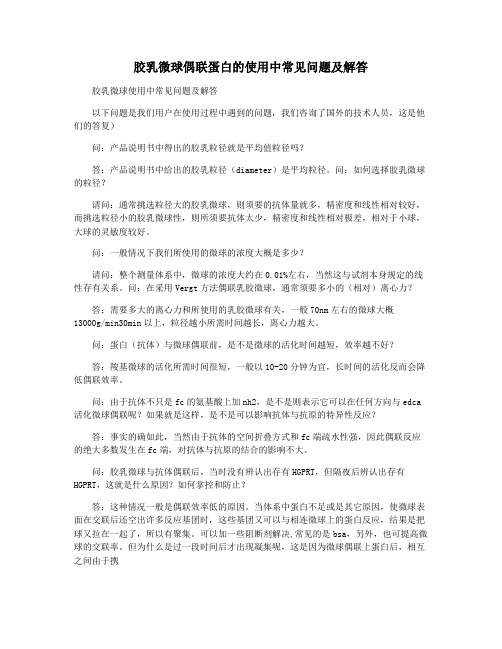
胶乳微球偶联蛋白的使用中常见问题及解答胶乳微球使用中常见问题及解答以下问题是我们用户在使用过程中遇到的问题,我们咨询了国外的技术人员,这是他们的答复)问:产品说明书中得出的胶乳粒径就是平均值粒径吗?答:产品说明书中给出的胶乳粒径(diameter)是平均粒径。
问:如何选择胶乳微球的粒径?请问:通常挑选粒径大的胶乳微球,则须要的抗体量就多,精密度和线性相对较好,而挑选粒径小的胶乳微球性,则所须要抗体太少,精密度和线性相对极差,相对于小球,大球的灵敏度较好。
问:一般情况下我们所使用的微球的浓度大概是多少?请问:整个测量体系中,微球的浓度大约在0.01%左右,当然这与试剂本身规定的线性存有关系。
问:在采用Vergt方法偶联乳胶微球,通常须要多小的(相对)离心力?答:需要多大的离心力和所使用的乳胶微球有关,一般70nm左右的微球大概13000g/min30min以上,粒径越小所需时间越长,离心力越大。
问:蛋白(抗体)与微球偶联前,是不是微球的活化时间越短,效率越不好?答:羧基微球的活化所需时间很短,一般以10-20分钟为宜,长时间的活化反而会降低偶联效率。
问:由于抗体不只是fc的氨基酸上加nh2,是不是则表示它可以在任何方向与edca 活化微球偶联呢?如果就是这样,是不是可以影响抗体与抗原的特异性反应?答:事实的确如此,当然由于抗体的空间折叠方式和fc端疏水性强,因此偶联反应的绝大多数发生在fc端,对抗体与抗原的结合的影响不大。
问:胶乳微球与抗体偶联后,当时没有辨认出存有HGPRT,但隔夜后辨认出存有HGPRT,这就是什么原因?如何掌控和防止?答:这种情况一般是偶联效率低的原因。
当体系中蛋白不足或是其它原因,使微球表面在交联后还空出许多反应基团时,这些基团又可以与相连微球上的蛋白反应,结果是把球又拉在一起了,所以有聚集。
可以加一些阻断剂解决,常见的是bsa,另外,也可提高微球的交联率。
但为什么是过一段时间后才出现凝集呢,这是因为微球偶联上蛋白后,相互之间由于携拎同种电荷的关系,比较稳定(所以能够以胶体样存有),只有当偶尔相互相撞,碰上彼此的反应基团时就可以融合。
Protocol2两步法偶联胶乳微球与抗体
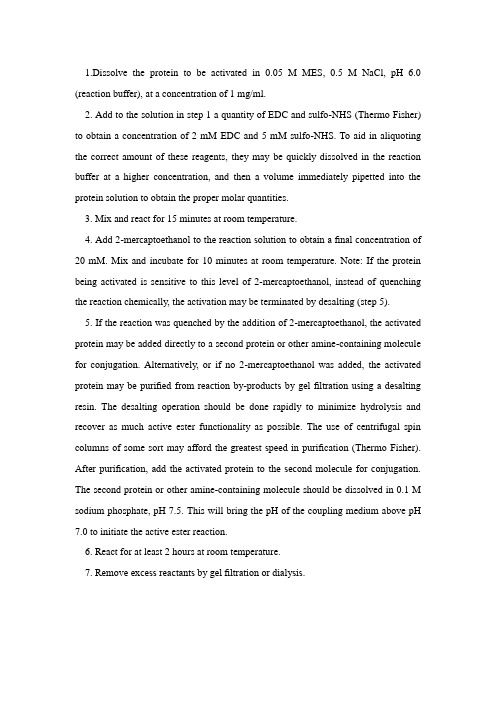
1.Dissolve the protein to be activated in 0.05 M MES, 0.5 M NaCl, pH 6.0 (reaction buffer), at a concentration of 1 mg/ml.2. Add to the solution in step 1 a quantity of EDC and sulfo-NHS (Thermo Fisher) to obtain a concentration of 2 mM EDC and 5 mM sulfo-NHS. To aid in aliquoting the correct amount of these reagents, they may be quickly dissolved in the reaction buffer at a higher concentration, and then a volume immediately pipetted into the protein solution to obtain the proper molar quantities.3. Mix and react for 15 minutes at room temperature.4. Add 2-mercaptoethanol to the reaction solution to obtain a final co ncentration of 20 mM. Mix and incubate for 10 minutes at room temperature. Note: If the protein being activated is sensitive to this level of 2-mercaptoethanol, instead of quenching the reaction chemically, the activation may be terminated by desalting (step 5).5. If the reaction was quenched by the addition of 2-mercaptoethanol, the activated protein may be added directly to a second protein or other amine-containing molecule for conjugation. Alternatively, or if no 2-mercaptoethanol was added, the activated protein may be purified from reaction by-products by gel filtration using a desalting resin. The desalting operation should be done rapidly to minimize hydrolysis and recover as much active ester functionality as possible. The use of centrifugal spin columns of some sort may affo rd the greatest speed in purification (Thermo Fisher). After purification, add the activated protein to the second molecule for conjugation. The second protein or other amine-containing molecule should be dissolved in 0.1 M sodium phosphate, pH 7.5. This will bring the pH of the coupling medium above pH 7.0 to initiate the active ester reaction.6. React for at least 2 hours at room temperature.7. Remove excess reactants by gel filtration or dialysis.。
体外诊断试剂胶乳比浊法学习
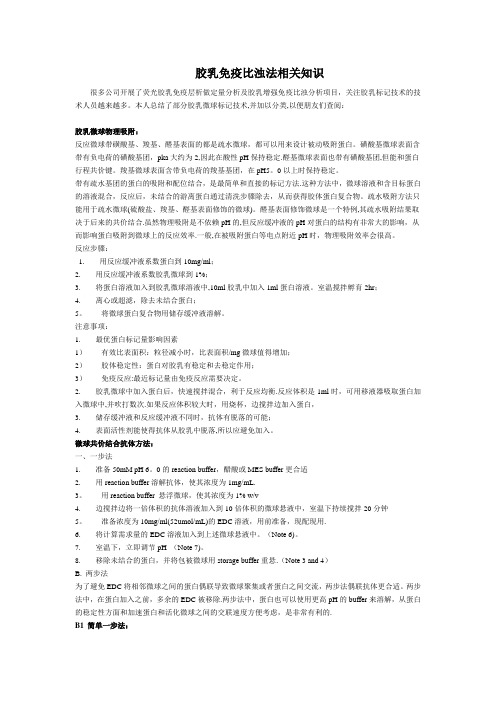
胶乳免疫比浊法相关知识很多公司开展了荧光胶乳免疫层析做定量分析及胶乳增强免疫比浊分析项目,关注胶乳标记技术的技术人员越来越多。
本人总结了部分胶乳微球标记技术,并加以分类,以便朋友们查阅:胶乳微球物理吸附:反应微球带磺酸基、羧基、醛基表面的都是疏水微球,都可以用来设计被动吸附蛋白。
磺酸基微球表面含带有负电荷的磺酸基团,pka大约为2,因此在酸性pH保持稳定.醛基微球表面也带有磺酸基团,但能和蛋白行程共价键。
羧基微球表面含带负电荷的羧基基团,在pH5。
0以上时保持稳定。
带有疏水基团的蛋白的吸附和配位结合,是最简单和直接的标记方法.这种方法中,微球溶液和含目标蛋白的溶液混合,反应后,未结合的游离蛋白通过清洗步骤除去,从而获得胶体蛋白复合物。
疏水吸附方法只能用于疏水微球(硫酸盐、羧基、醛基表面修饰的微球)。
醛基表面修饰微球是一个特例,其疏水吸附结果取决于后来的共价结合.虽然物理吸附是不依赖pH的,但反应缓冲液的pH对蛋白的结构有非常大的影响,从而影响蛋白吸附到微球上的反应效率.一般,在被吸附蛋白等电点附近pH时,物理吸附效率会很高。
反应步骤:1.用反应缓冲液系数蛋白到10mg/ml;2.用反应缓冲液系数胶乳微球到1%;3.将蛋白溶液加入到胶乳微球溶液中,10ml胶乳中加入1ml蛋白溶液。
室温搅拌孵育2hr;4.离心或超滤,除去未结合蛋白;5。
将微球蛋白复合物用储存缓冲液溶解。
注意事项:1.最优蛋白标记量影响因素1)有效比表面积:粒径减小时,比表面积/mg微球值得增加;2)胶体稳定性:蛋白对胶乳有稳定和去稳定作用;3)免疫反应:最近标记量由免疫反应需要决定。
2.胶乳微球中加入蛋白后,快速搅拌混合,利于反应均衡.反应体积是1ml时,可用移液器吸取蛋白加入微球中,并吹打数次.如果反应体积较大时,用烧杯,边搅拌边加入蛋白,3.储存缓冲液和反应缓冲液不同时,抗体有脱落的可能;4.表面活性剂能使得抗体从胶乳中脱落,所以应避免加入。
乳胶微球偶联方法
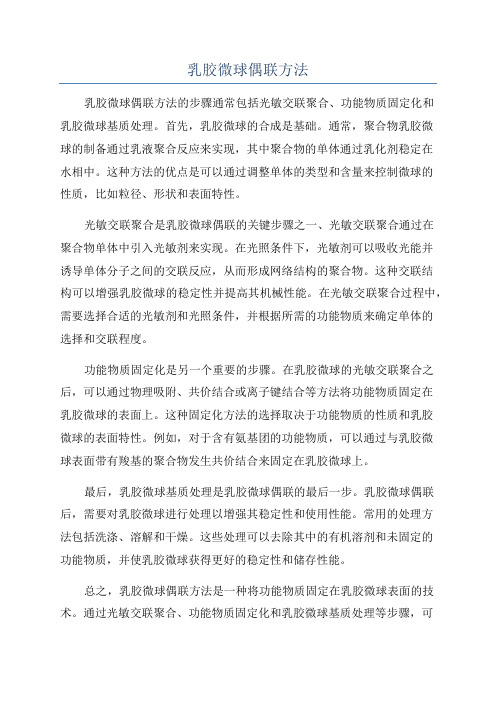
乳胶微球偶联方法乳胶微球偶联方法的步骤通常包括光敏交联聚合、功能物质固定化和乳胶微球基质处理。
首先,乳胶微球的合成是基础。
通常,聚合物乳胶微球的制备通过乳液聚合反应来实现,其中聚合物的单体通过乳化剂稳定在水相中。
这种方法的优点是可以通过调整单体的类型和含量来控制微球的性质,比如粒径、形状和表面特性。
光敏交联聚合是乳胶微球偶联的关键步骤之一、光敏交联聚合通过在聚合物单体中引入光敏剂来实现。
在光照条件下,光敏剂可以吸收光能并诱导单体分子之间的交联反应,从而形成网络结构的聚合物。
这种交联结构可以增强乳胶微球的稳定性并提高其机械性能。
在光敏交联聚合过程中,需要选择合适的光敏剂和光照条件,并根据所需的功能物质来确定单体的选择和交联程度。
功能物质固定化是另一个重要的步骤。
在乳胶微球的光敏交联聚合之后,可以通过物理吸附、共价结合或离子键结合等方法将功能物质固定在乳胶微球的表面上。
这种固定化方法的选择取决于功能物质的性质和乳胶微球的表面特性。
例如,对于含有氨基团的功能物质,可以通过与乳胶微球表面带有羧基的聚合物发生共价结合来固定在乳胶微球上。
最后,乳胶微球基质处理是乳胶微球偶联的最后一步。
乳胶微球偶联后,需要对乳胶微球进行处理以增强其稳定性和使用性能。
常用的处理方法包括洗涤、溶解和干燥。
这些处理可以去除其中的有机溶剂和未固定的功能物质,并使乳胶微球获得更好的稳定性和储存性能。
总之,乳胶微球偶联方法是一种将功能物质固定在乳胶微球表面的技术。
通过光敏交联聚合、功能物质固定化和乳胶微球基质处理等步骤,可以制备出具有特定功能和稳定性的乳胶微球。
这种方法具有简单、灵活和可控性强等特点,并在催化剂、生物传感器和药物释放等领域具有广泛的应用前景。
一种微球与抗体的定向偶联方法及应用与流程

一种微球与抗体的定向偶联方法及应用与流程
一种微球与抗体的定向偶联方法是通过生物素-亲和素相互作用实现。
该方法需要以下材料和步骤:
材料:
1. 微球:通常选择具有较大比表面积和良好的稳定性的微球,如磁性微球或聚合物微球。
2. 抗体:选择目标分子特异性的抗体。
步骤:
1. 微球表面修饰:将微球表面引入生物素官能团。
这可以通过直接合成或修饰微球表面的化学反应来实现。
2. 生物素修饰的抗体制备:将抗体与生物素分子结合,使抗体表面具有生物素官能团。
这可以通过化学交联或生物化学方法(如使用生物素化的抗体)来实现。
3. 微球与抗体的定向偶联:将生物素修饰的微球与生物素修饰的抗体进行反应,利用生物素-亲和素相互作用实现微球与抗体的定向偶联。
这可以在适当的缓冲液中进行,并通过控制反应条件(如反应时间、温度等)来优化偶联效率。
4. 优化及鉴定:根据具体的应用需要,可以进一步优化定向偶联方法,如调整微球和抗体的浓度或反应时间等。
最后,使用适当的方法(如免疫荧光染色、酶联免疫吸附分析等)来验证定向偶联的效果。
应用:
微球与抗体的定向偶联方法在生物分析、生物传感器和药物传递等领域具有广泛的应用。
例如,在生物分析中,可以利用微球上的抗体将目标分子捕获到微球表面,并通过
检测抗原-抗体反应来定量分析目标分子的存在和浓度。
另外,通过将药物修饰到微球上,可以实现靶向药物传递,提高治疗效果并减少副作用。
胶乳微球与抗体蛋白相互作用机理的荧光光谱法分析
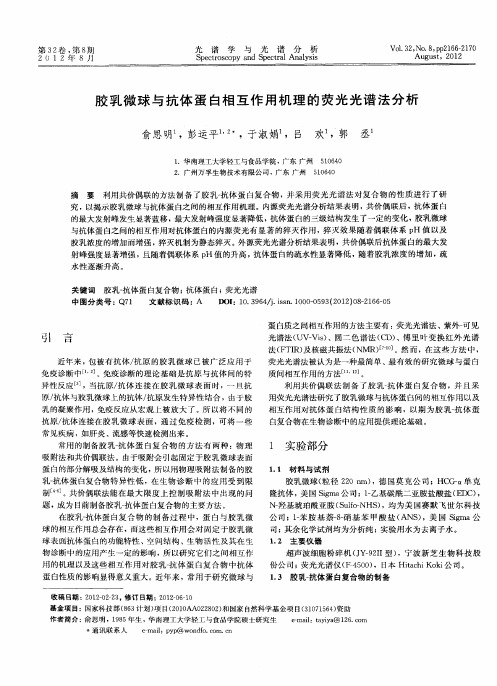
光谱法 ( _ s 、圆二 色谱法 ( D) uv ) C 、傅里 叶变换 红外 光谱
法 ( I R 及核磁共振法 ( K' ) I NMR)7 。 而 ,在这 些方 法 中, Ⅲ。 然 。
乳 的凝 聚作用 , 免疫反应从宏观上被放 大 了。所以将不 同的 抗原 / 抗体连接在胶乳 微球 表 面,通 过免 疫检 测 ,可将 一些 常见 疾病 , 如肝炎 、流感等快速检测 出来 。 常用 的制备胶乳一 体蛋 白复合 物 的方法 有两 种 :物理 抗 吸附法和共价偶联法。由于吸附会引起固定于胶乳 微球表 面 蛋 白的部分解 吸及结构的变化 , 以用物理吸 附法制备 的胶 所 乳一 抗体蛋 白复合物特 异性低 ,在生物 诊 断 中的应用 受到 限 制Ⅲ ] 4 。共价偶联法能在最 大 限度 上控 制吸 附法 中出现 的问 题 , 为 目前制备胶乳一 成 抗体蛋 白复合物 的主要方法 。 在胶乳一 抗体蛋 白复合 物 的制备 过程 中 , 白 与胶乳 微 蛋
公司 ;1苯 胺基 萘一一 - 8硝基 苯 甲酸 盐 ( ANS ,美 国 Sg ) ima公
球的相互作用总会存在 , 而这些相互作用会 对 固定 于胶 乳微
球表面抗体蛋 白的功能特性 、空间结构 、生物 活性及其 在生 物诊断 中的应用产 生一定 的影 响,所以研 究它们之 问相互作 用 的机理 以及这些 相互作 用对胶 乳一 抗体蛋 白复合 物 中抗体
司; 其余化学试剂均为分析纯 ;实验用水为去离子水 。
1 2 主要 仪 器 .
超 声 波 细 胞 粉 碎 机 (Y 9 I 型 ) J -2I ,宁 波 新 芝 生 物 科 技 股
体外诊断试剂胶乳比浊法学习之欧阳治创编
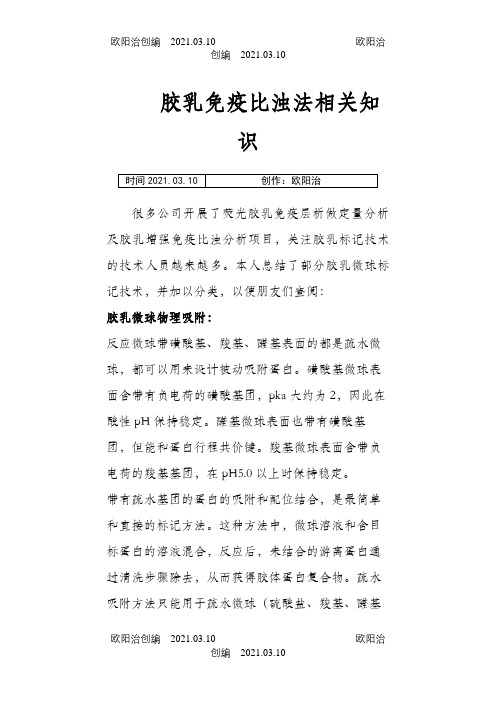
胶乳免疫比浊法相关知识很多公司开展了荧光胶乳免疫层析做定量分析及胶乳增强免疫比浊分析项目,关注胶乳标记技术的技术人员越来越多。
本人总结了部分胶乳微球标记技术,并加以分类,以便朋友们查阅:胶乳微球物理吸附:反应微球带磺酸基、羧基、醛基表面的都是疏水微球,都可以用来设计被动吸附蛋白。
磺酸基微球表面含带有负电荷的磺酸基团,pka大约为2,因此在酸性pH保持稳定。
醛基微球表面也带有磺酸基团,但能和蛋白行程共价键。
羧基微球表面含带负电荷的羧基基团,在pH5.0以上时保持稳定。
带有疏水基团的蛋白的吸附和配位结合,是最简单和直接的标记方法。
这种方法中,微球溶液和含目标蛋白的溶液混合,反应后,未结合的游离蛋白通过清洗步骤除去,从而获得胶体蛋白复合物。
疏水吸附方法只能用于疏水微球(硫酸盐、羧基、醛基表面修饰的微球)。
醛基表面修饰微球是一个特例,其疏水吸附结果取决于后来的共价结合。
虽然物理吸附是不依赖pH的,但反应缓冲液的pH对蛋白的结构有非常大的影响,从而影响蛋白吸附到微球上的反应效率。
一般,在被吸附蛋白等电点附近pH时,物理吸附效率会很高。
反应步骤:1. 用反应缓冲液系数蛋白到10mg/ml;2. 用反应缓冲液系数胶乳微球到1%;3. 将蛋白溶液加入到胶乳微球溶液中,10ml胶乳中加入1ml蛋白溶液。
室温搅拌孵育2hr;4. 离心或超滤,除去未结合蛋白;5. 将微球蛋白复合物用储存缓冲液溶解。
注意事项:1. 最优蛋白标记量影响因素1)有效比表面积:粒径减小时,比表面积/mg微球值得增加;2)胶体稳定性:蛋白对胶乳有稳定和去稳定作用;3)免疫反应:最近标记量由免疫反应需要决定。
2. 胶乳微球中加入蛋白后,快速搅拌混合,利于反应均衡。
反应体积是1ml时,可用移液器吸取蛋白加入微球中,并吹打数次。
如果反应体积较大时,用烧杯,边搅拌边加入蛋白,3. 储存缓冲液和反应缓冲液不同时,抗体有脱落的可能;4. 表面活性剂能使得抗体从胶乳中脱落,所以应避免加入。
体外诊断试剂胶乳比浊法学习

胶乳免疫比浊法相关知识很多公司开展了荧光胶乳免疫层析做定量分析及胶乳增强免疫比浊分析项目,关注胶乳标记技术的技术人员越来越多。
本人总结了部分胶乳微球标记技术,并加以分类,以便朋友们查阅:胶乳微球物理吸附:反应微球带磺酸基、羧基、醛基表面的都是疏水微球,都可以用来设计被动吸附蛋白。
磺酸基微球表面含带有负电荷的磺酸基团,pka大约为2,因此在酸性pH保持稳定.醛基微球表面也带有磺酸基团,但能和蛋白行程共价键。
羧基微球表面含带负电荷的羧基基团,在pH5。
0以上时保持稳定。
带有疏水基团的蛋白的吸附和配位结合,是最简单和直接的标记方法.这种方法中,微球溶液和含目标蛋白的溶液混合,反应后,未结合的游离蛋白通过清洗步骤除去,从而获得胶体蛋白复合物。
疏水吸附方法只能用于疏水微球(硫酸盐、羧基、醛基表面修饰的微球)。
醛基表面修饰微球是一个特例,其疏水吸附结果取决于后来的共价结合.虽然物理吸附是不依赖pH的,但反应缓冲液的pH对蛋白的结构有非常大的影响,从而影响蛋白吸附到微球上的反应效率.一般,在被吸附蛋白等电点附近pH时,物理吸附效率会很高。
反应步骤:1.用反应缓冲液系数蛋白到10mg/ml;2.用反应缓冲液系数胶乳微球到1%;3.将蛋白溶液加入到胶乳微球溶液中,10ml胶乳中加入1ml蛋白溶液。
室温搅拌孵育2hr;4.离心或超滤,除去未结合蛋白;5。
将微球蛋白复合物用储存缓冲液溶解。
注意事项:1.最优蛋白标记量影响因素1)有效比表面积:粒径减小时,比表面积/mg微球值得增加;2)胶体稳定性:蛋白对胶乳有稳定和去稳定作用;3)免疫反应:最近标记量由免疫反应需要决定。
2.胶乳微球中加入蛋白后,快速搅拌混合,利于反应均衡.反应体积是1ml时,可用移液器吸取蛋白加入微球中,并吹打数次.如果反应体积较大时,用烧杯,边搅拌边加入蛋白,3.储存缓冲液和反应缓冲液不同时,抗体有脱落的可能;4.表面活性剂能使得抗体从胶乳中脱落,所以应避免加入。
羧基乳胶微球偶联方法
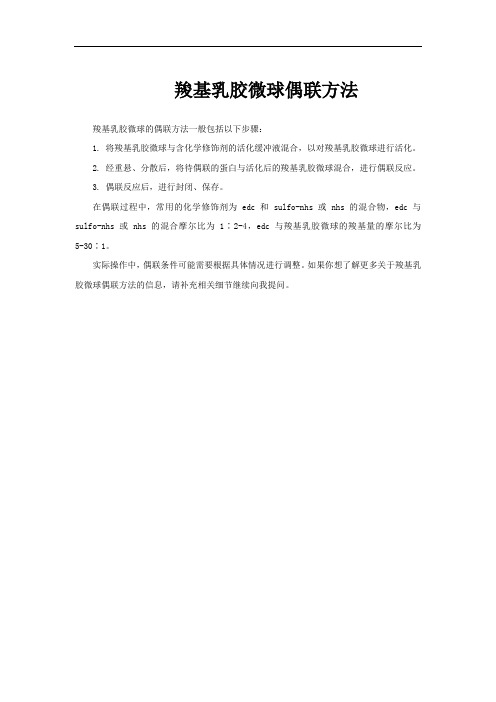
羧基乳胶微球偶联方法
羧基乳胶微球的偶联方法一般包括以下步骤:
1. 将羧基乳胶微球与含化学修饰剂的活化缓冲液混合,以对羧基乳胶微球进行活化。
2. 经重悬、分散后,将待偶联的蛋白与活化后的羧基乳胶微球混合,进行偶联反应。
3. 偶联反应后,进行封闭、保存。
在偶联过程中,常用的化学修饰剂为edc 和 sulfo-nhs 或 nhs 的混合物,edc 与sulfo-nhs 或 nhs 的混合摩尔比为1∶2-4,edc 与羧基乳胶微球的羧基量的摩尔比为5-30∶1。
实际操作中,偶联条件可能需要根据具体情况进行调整。
如果你想了解更多关于羧基乳胶微球偶联方法的信息,请补充相关细节继续向我提问。
一种羧基乳胶微球与抗体的偶联方法
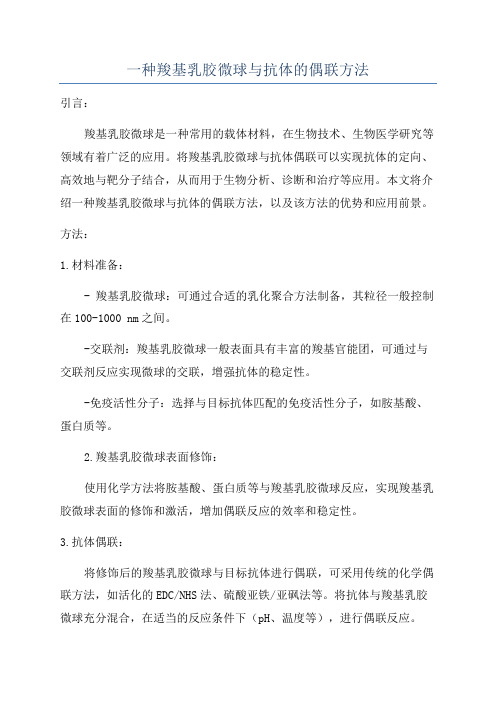
一种羧基乳胶微球与抗体的偶联方法引言:羧基乳胶微球是一种常用的载体材料,在生物技术、生物医学研究等领域有着广泛的应用。
将羧基乳胶微球与抗体偶联可以实现抗体的定向、高效地与靶分子结合,从而用于生物分析、诊断和治疗等应用。
本文将介绍一种羧基乳胶微球与抗体的偶联方法,以及该方法的优势和应用前景。
方法:1.材料准备:- 羧基乳胶微球:可通过合适的乳化聚合方法制备,其粒径一般控制在100-1000 nm之间。
-交联剂:羧基乳胶微球一般表面具有丰富的羧基官能团,可通过与交联剂反应实现微球的交联,增强抗体的稳定性。
-免疫活性分子:选择与目标抗体匹配的免疫活性分子,如胺基酸、蛋白质等。
2.羧基乳胶微球表面修饰:使用化学方法将胺基酸、蛋白质等与羧基乳胶微球反应,实现羧基乳胶微球表面的修饰和激活,增加偶联反应的效率和稳定性。
3.抗体偶联:将修饰后的羧基乳胶微球与目标抗体进行偶联,可采用传统的化学偶联方法,如活化的EDC/NHS法、硫酸亚铁/亚砜法等。
将抗体与羧基乳胶微球充分混合,在适当的反应条件下(pH、温度等),进行偶联反应。
4.反应后的处理:偶联反应后,通过洗涤等方法去除未偶联的抗体和副产物,得到羧基乳胶微球与抗体稳定结合的产物。
优势和应用前景:-选择合适的乳化聚合方法和交联剂,可控制羧基乳胶微球的粒径和形貌,使其具有较大比表面积和较好的稳定性。
-通过表面修饰,增加羧基乳胶微球与抗体之间的亲和力和稳定性,提高偶联效率。
-该方法操作简单、成本较低,适用于大规模生产。
-偶联的羧基乳胶微球具有良好的生物相容性和稳定性,可用于体内外生物学研究、诊断和治疗等领域。
-偶联的羧基乳胶微球可用于靶向传递药物、检测靶分子、研究生物分子交互作用等应用。
总结:本文介绍了一种羧基乳胶微球与抗体的偶联方法,该方法可以实现抗体的定向、高效地与靶分子结合。
该方法具有操作简单、成本低、适用性广等优点,并在生物学研究、诊断和治疗等领域具有广阔的应用前景。
一种偶联抗体的荧光微球及其制备方法与用途[发明专利]
![一种偶联抗体的荧光微球及其制备方法与用途[发明专利]](https://img.taocdn.com/s3/m/4397a4fca0c7aa00b52acfc789eb172dec63994d.png)
(19)中华人民共和国国家知识产权局(12)发明专利申请(10)申请公布号 (43)申请公布日 (21)申请号 202010576144.7(22)申请日 2020.06.22(71)申请人 武汉生之源生物科技股份有限公司地址 430000 湖北省武汉市东湖开发区高新大道818号高科医疗器械园B11号1楼、2楼、3楼(72)发明人 杨文 李文叶 黄玲 舒芹 张雪娇 赵愿安 (74)专利代理机构 北京众达德权知识产权代理有限公司 11570代理人 江慧(51)Int.Cl.G01N 33/533(2006.01)G01N 33/58(2006.01)G01N 33/558(2006.01)(54)发明名称一种偶联抗体的荧光微球及其制备方法与用途(57)摘要本发明公开了一种偶联抗体的荧光微球及其制备方法与用途,将荧光微球溶液、NHS和EDC溶液在超声波条件下活化反应,后离心、分离、稀释分散获得活化荧光微球溶液;将活化荧光微球溶液与抗体溶液在超声波条件下进行偶联反应获得偶联反应液;将偶联反应液与封闭液在超声波条件下进行封闭反应,获得封闭反应液;将所述封闭反应液离心、分离,复溶后混匀获得偶联抗体的荧光微球;所述超声波条件均为:超声波频率20KHZ~80KHZ,采用多次超声方式,相邻两次超声之间存在间隔时间,其中,单次超声时间3~10s,间隔时间为3~10s,超声总时间为3min~30min。
有效提升反应偶联效率,偶联抗体的荧光微球均一性与稳定性好。
权利要求书1页 说明书13页 附图1页CN 111879921 A 2020.11.03C N 111879921A1.一种偶联抗体的荧光微球的制备方法,其特征在于,所述方法包括:获得荧光微球溶液、NHS溶液、EDC溶液和交联反应溶液;将所述荧光微球溶液、所述NHS溶液和所述EDC溶液在第一超声波条件下进行活化反应,后进行离心和/或固液分离,获得第一固体,将所述第一固体使用所述交联反应溶液稀释,后分散,获得活化荧光微球溶液;获得抗体溶液;将所述活化荧光微球溶液与所述抗体溶液混匀,后在第二超声波条件下进行偶联反应,获得偶联反应液;获得封闭液;将所述偶联反应液与所述封闭液混匀,后在第三超声波条件下进行封闭反应,获得封闭反应液;获得复溶溶液;将所述封闭反应液进行离心和/或固液分离,获得第二固体,将所述第二固体用所述复溶溶液重悬后混匀,获得偶联抗体的荧光微球;所述第一超声波条件、所述第二超声波条件和所述第三超声波条件均为:超声波频率为20KHZ~80KHZ,采用多次超声方式,且相邻两次超声之间存在间隔时间,其中,单次超声时间为3~10s,单次间隔时间为3~10s,超声总时间为3min~30min。
一种微球与抗体的定向偶联方法及应用与流程 (4)
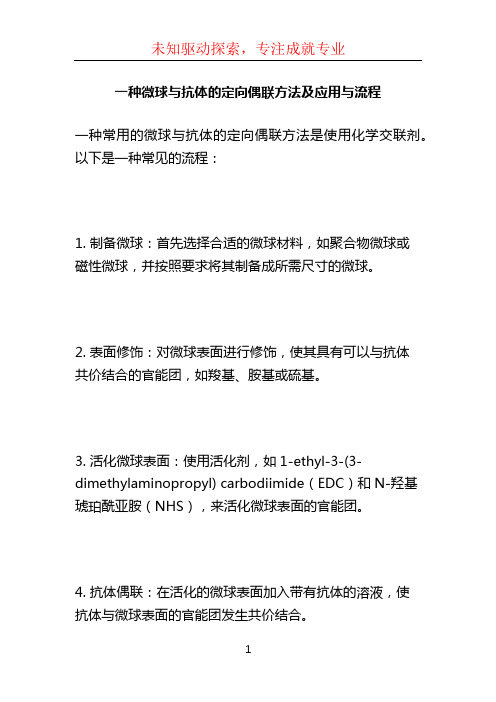
一种微球与抗体的定向偶联方法及应用与流程一种常用的微球与抗体的定向偶联方法是使用化学交联剂。
以下是一种常见的流程:1. 制备微球:首先选择合适的微球材料,如聚合物微球或磁性微球,并按照要求将其制备成所需尺寸的微球。
2. 表面修饰:对微球表面进行修饰,使其具有可以与抗体共价结合的官能团,如羧基、胺基或硫基。
3. 活化微球表面:使用活化剂,如1-ethyl-3-(3-dimethylaminopropyl) carbodiimide(EDC)和N-羟基琥珀酰亚胺(NHS),来活化微球表面的官能团。
4. 抗体偶联:在活化的微球表面加入带有抗体的溶液,使抗体与微球表面的官能团发生共价结合。
5. 反应停止:通过洗涤去除未结合的抗体和其他副产物,停止偶联反应。
6. 确认偶联效果:使用荧光染料或其他标记物对微球表面的抗体进行标记,然后使用显微镜或流式细胞仪等设备检测标记物的存在,确认抗体成功偶联到微球表面。
应用:1. 免疫分析:将偶联了特定抗体的微球用于检测目标分子,如细胞表面标志物或蛋白质浓度。
通过与目标分子的特异性结合,可以实现高灵敏度和高选择性的检测。
2. 药物传递:将偶联了药物的微球用于靶向治疗。
通过偶联到药物上的抗体,可以实现对特定细胞或组织的定向输送,提高治疗效果并降低对非靶向区域的毒副作用。
3. 细胞分选:将偶联了特定抗体的微球用于分选特定类型的细胞。
通过与目标细胞的特异性结合,可以实现对特定细胞的捕获和分离。
总结:微球与抗体的定向偶联方法可以实现对特定分子或细胞的定向识别和作用,具有广泛的应用前景。
不同的实验需要选择合适的微球材料和抗体,并根据具体的实验要求进行相应的修饰和偶联过程。
抗体,胶乳基本偶联步骤
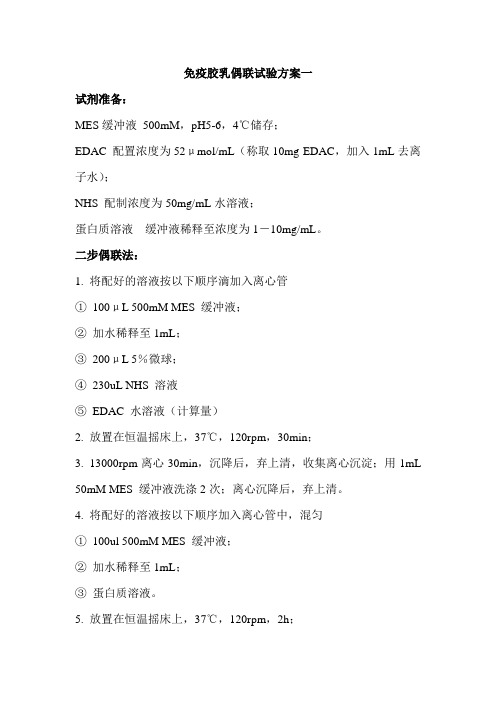
免疫胶乳偶联试验方案一试剂准备:MES缓冲液500mM,pH5-6,4℃储存;EDAC 配置浓度为52μmol/mL(称取10mg EDAC,加入1mL去离子水);NHS 配制浓度为50mg/mL水溶液;蛋白质溶液缓冲液稀释至浓度为1-10mg/mL。
二步偶联法:1. 将配好的溶液按以下顺序滴加入离心管①100μL 500mM MES 缓冲液;②加水稀释至1mL;③200μL 5%微球;④230uL NHS 溶液⑤EDAC 水溶液(计算量)2. 放置在恒温摇床上,37℃,120rpm,30min;3. 13000rpm离心30min,沉降后,弃上清,收集离心沉淀;用1mL 50mM MES 缓冲液洗涤2次;离心沉降后,弃上清。
4. 将配好的溶液按以下顺序加入离心管中,混匀①100ul 500mM MES 缓冲液;②加水稀释至1mL;③蛋白质溶液。
5. 放置在恒温摇床上,37℃,120rpm,2h;6. 13000rpm离心20min沉降后,弃上清,收集离心沉淀;用1mL 50mM MES 缓冲液(或者调节pH至8.0左右),同时加入BSA溶液至其终浓度为1%,洗涤3 次;离心沉降后,弃上清。
7. 加入0.97mL MES 缓冲液(或者调节pH至8.0左右),将微球浓度调为1%,并重新悬浮,然后搅拌,接着温和的超声分散;8. 重新悬浮后加入一定量的BSA溶液(比如终浓度为1%),保存。
9.福林酚法测定偶联蛋白质含量(可选)。
(如要测蛋白质含量,则前面的方法中不可加入BSA。
)1. 每ml反应混合物加入以下成分:加入DIW,定容最终体积为1ml;0.1ml 10X的MES buffer,ph6.0~6.5(10X的buffer通常用0.5M);0.1ml 10%的微球(终浓度为1%);0.23ml NHS水溶液(50mg/mL); 11.5mg一定体积的19.2mg/ml(100mM)的EDAC水溶液;2. 室温下搅拌反应15~30min;(Note7)3. 清洗:MES buffer或DIW清洗两次;(Note3);4. 用MES buffe或者DIW悬浮微球到浓度为1%;5. 同时,用MES buffe r溶解稀释抗体。
- 1、下载文档前请自行甄别文档内容的完整性,平台不提供额外的编辑、内容补充、找答案等附加服务。
- 2、"仅部分预览"的文档,不可在线预览部分如存在完整性等问题,可反馈申请退款(可完整预览的文档不适用该条件!)。
- 3、如文档侵犯您的权益,请联系客服反馈,我们会尽快为您处理(人工客服工作时间:9:00-18:30)。
1. Dissolve the protein to be modified at a concentration of 1–10 mg/ml in 0.1 M sodium phosphate, pH 7.4. NaCl may be added to this buffer if desired. For the modifi cation of keyhole limpet hemocyanin (KLH; Thermo Fisher) as described by Staros et al., 1986, include 0.9 M NaCl to maintain the solubility of this high-molecular-weight protein.If lower or higher concentrations of the protein are used, adjust the amounts of the other reactants as necessary to maintain the correct molar ratios.
2. Dissolve the molecule to be coupled in the same buffer used in step 1. For small molecules, add them to the reaction in at least a 10-fold molar excess over the amount of protein present. If possible, the molecule may be added directly to the protein solution in the appropriate excess. Alternatively, dissolve the molecule in the buffer at a higher concentration, and then add an aliquot of this stock solution to the protein solution.
3. Add the solution prepared in step 2 to the protein solution to obtain at least a 10-fold molar excess of small molecule to protein.
4. Add EDC (Thermo Fisher) to the above solution to obtain at least a 10-fold molar excess of EDC over the amount of protein present. Alternatively, a 0.05–0.1 M EDC concentrationin the reaction usually works well. Also, add sulfo-NHS (Thermo Fisher) to the reaction to bring its final concentration to 5 mM. To make it easier to add the correct quantity of EDC or sulfo-NHS, higher concentration stock solutions may be prepared if they are dissolved and used immediately. Mix to dissolve. If this ratio of EDC/sulfo-NHS to peptide or protein results in precipitation, scale back the amount of addition until a soluble conjugate is obtained.
5. React for 2 hours at room temperature.
6. Purify the conjugate by gel filtration or dialysis using the buffer of choice (for many conjugates 0.01 M sodium phosphate, 0.15 M NaCl, pH
7.4 is appropriate). If some turbidity has formed during the conjugation procedure, it may be removed by centrifugation or filtration.。
